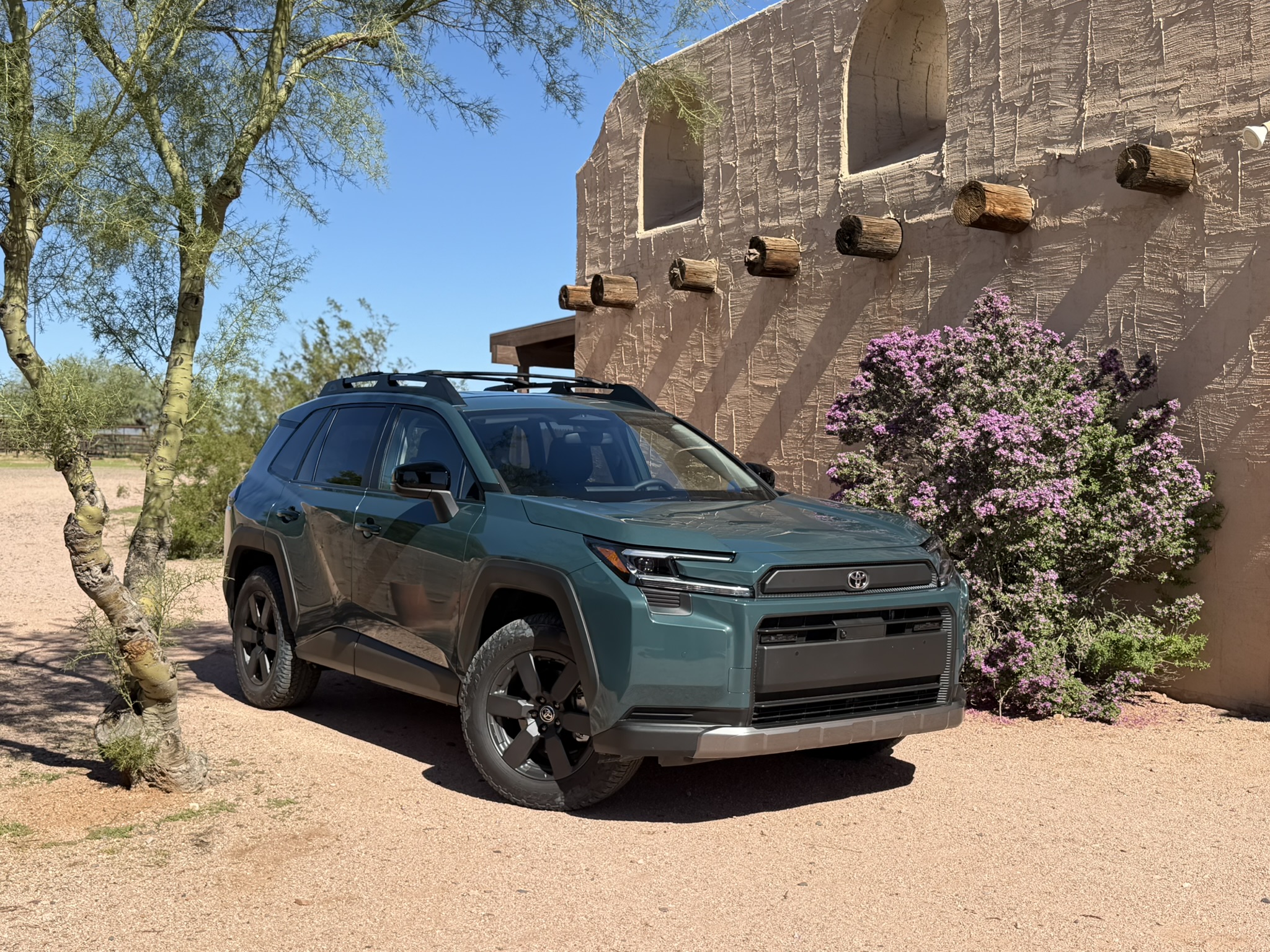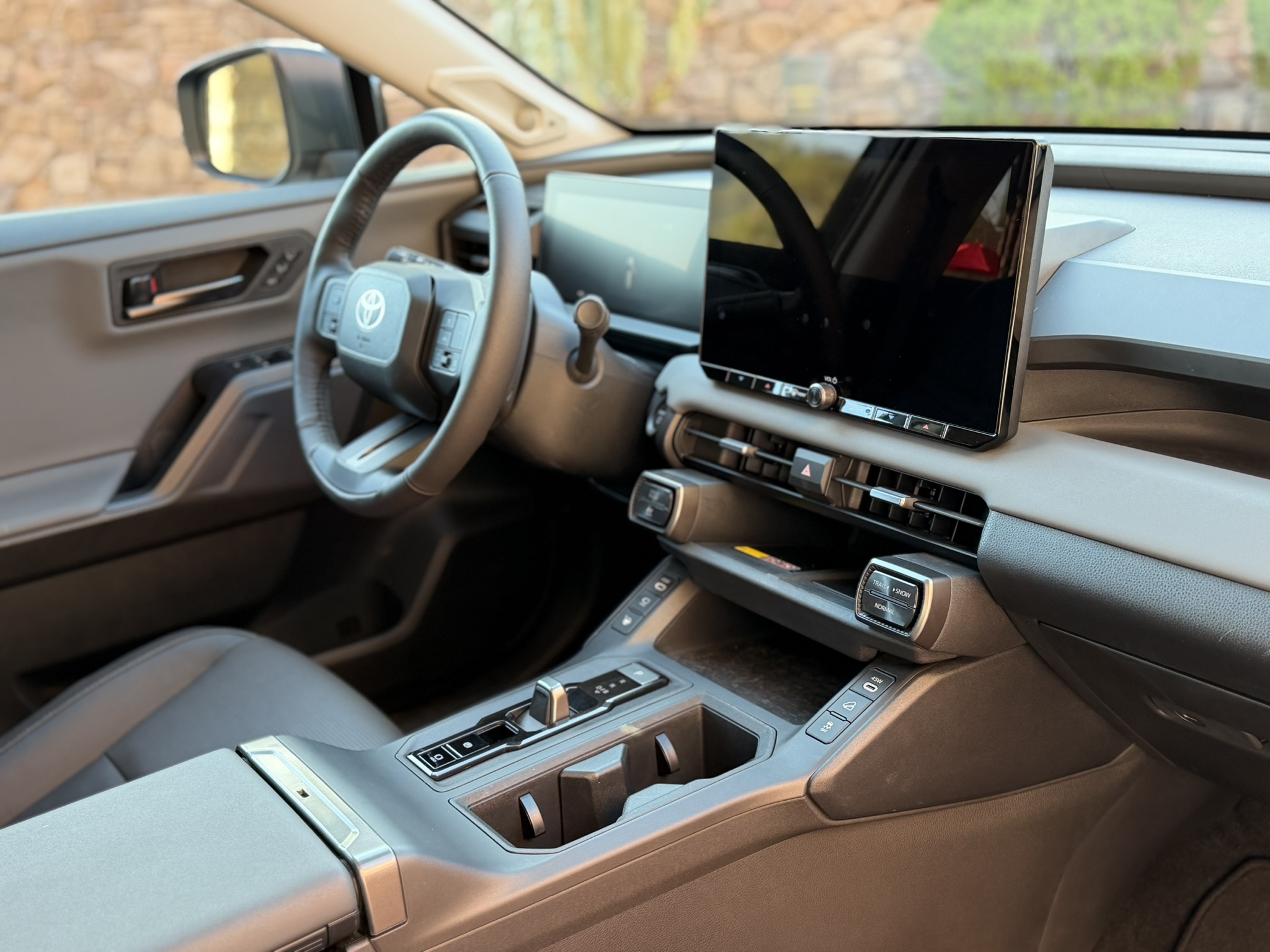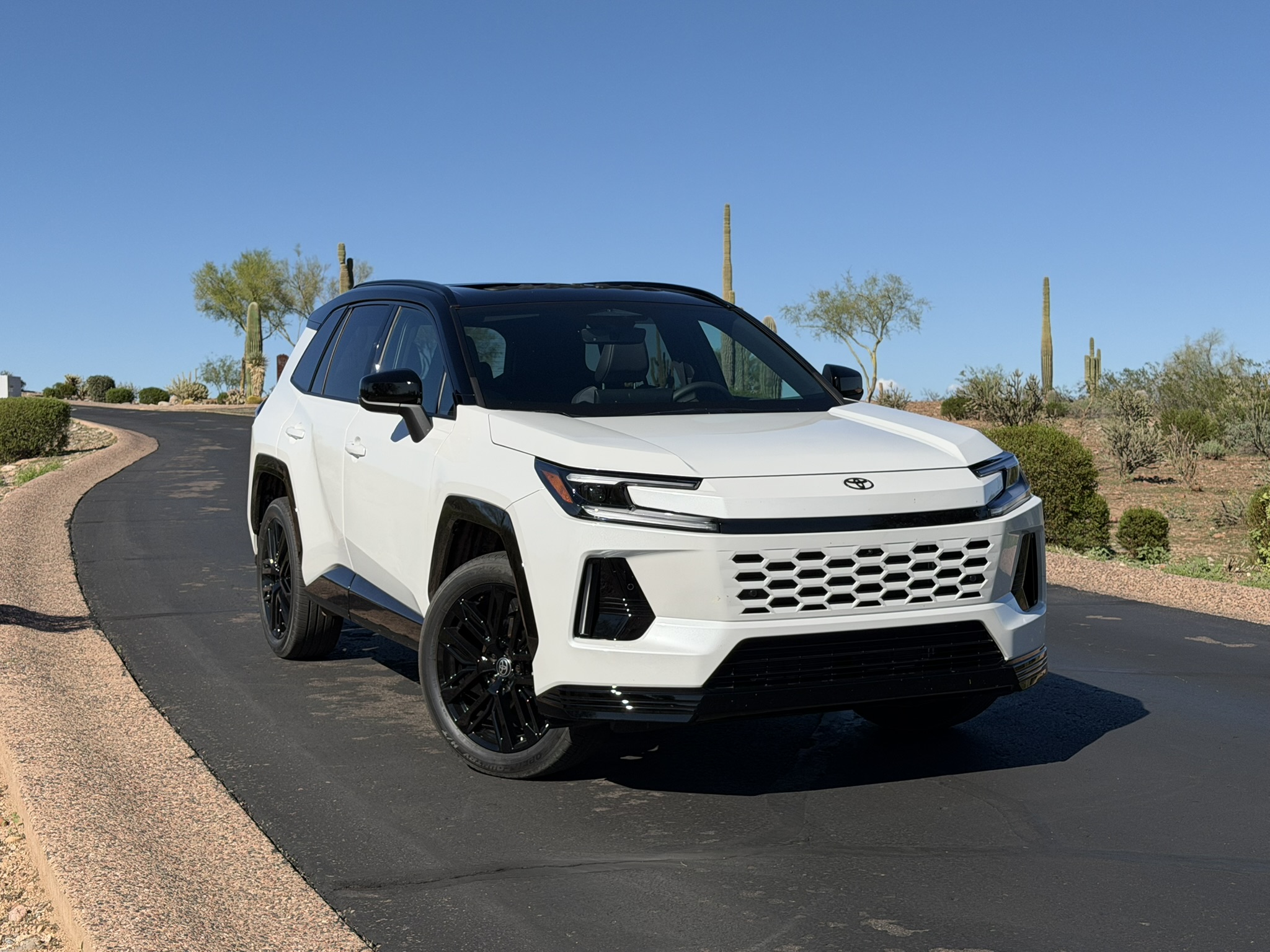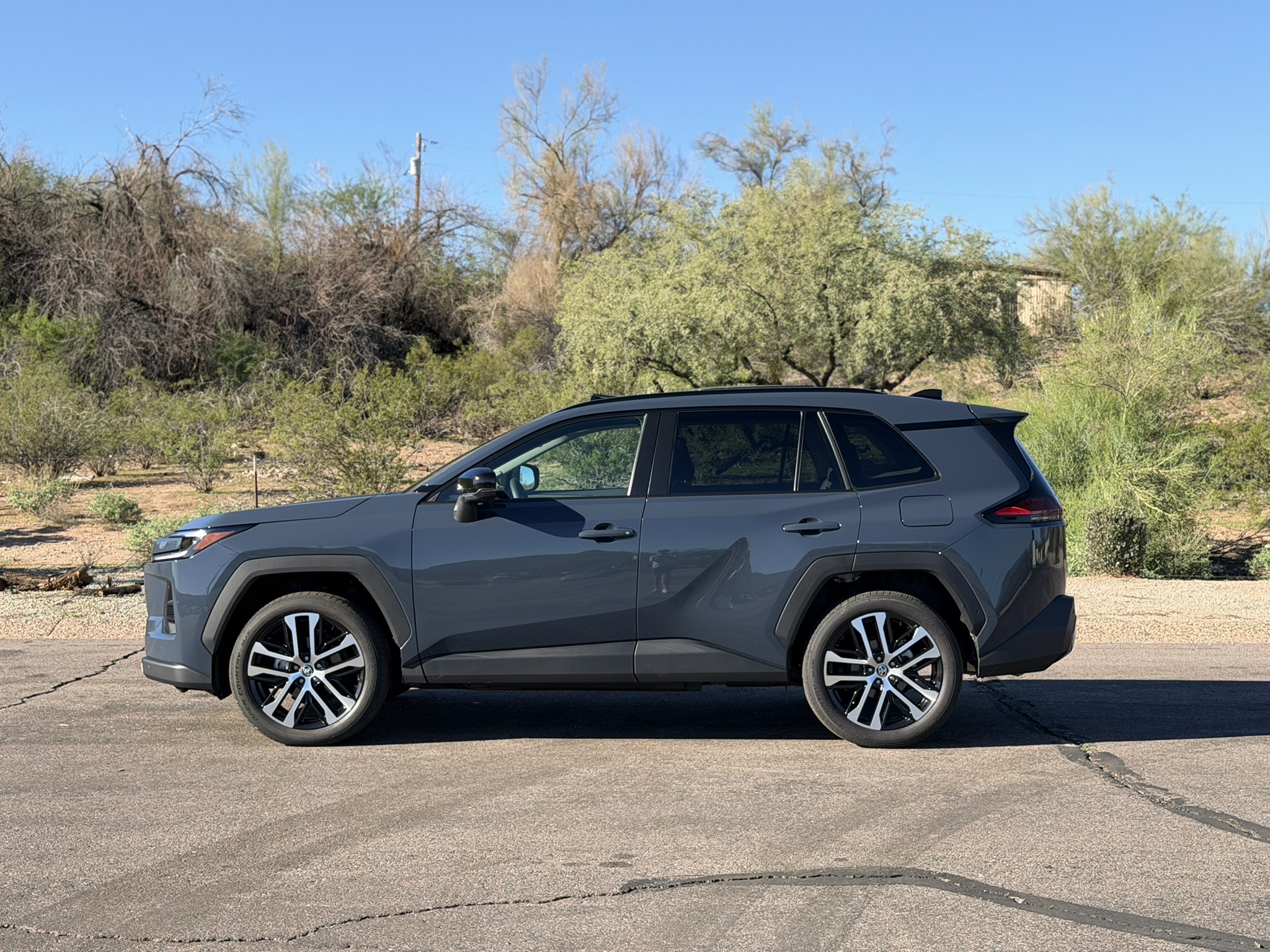2026 Toyota RAV4
Versatility at its finest with a new approach to the lineup
Toyota recently took the wraps off the all-new 2026 Toyota RAV4 which has been in production for over 30 years since it first debuted in 1994. When it first launched, the original RAV4 was a compact SUV available as a three or five door with a removable roof similar to the old Geo Tracker. It has long since grown up to be one of the best-selling vehicles in the United States with over 475,000 units sold in 2024. Now entering its sixth generation, the new RAV4 is available in three lines known as Core, Rugged, and Sport. Within these three lines are seven different grades buyers can choose from to find a RAV4 that best suits their personality and lifestyle. All models are relatively the same size and seat five passengers. Among the new models are the first ever GR Sport which is tuned for some more spirited driving and the Woodland grade built for hitting the dirt road.
New for 2026, the RAV4 is now 100% electrified with your choice of either a hybrid or plug-in hybrid powertrain. Don’t let that deter you though, as these powertrains are the most efficient and most powerful ever found in a RAV4. Standard Hybrid models are equipped with a 2.5L 4-cylinder DOHC paired with an electric motor to deliver 226 horsepower (FWD) or 236 horsepower (AWD) combined and 163 lb.-ft. of torque. By comparison, the 2025 standard gasoline model RAV4 maxed out at 203 horsepower. Also available for 2026 is the plug-in hybrid (PHEV) model which pairs the 2.5L 4-cylinder DOHC with two electric motors to deliver 324 combined horsepower and 172 lb.-ft. of torque (an increase from 2025’s top output of 302 horsepower). PHEV models all offer an electric-only driving range of around 50 miles depending on the grade.
Inside, the RAV4 debuts TSS 4.0 and Toyota Audio Multimedia 2.0 with a larger 10.5” touchscreen standard on LE, XLE, SE, and Woodland or a 12.9” touchscreen on the Limited, XSE, or GR Sport. The new digital drivers display has crisper graphics, integrated maps and customization on the left side of the screen and ADAA on the right. Pricing will start in the low $30k range for a FWD LE model. 2025 hybrid models started around $33k and climbed into the mid $45k range for the plug-in hybrid (for estimation purposes). Competition in the compact crossover segment is fierce with primary competitors being the Honda CR-V, Hyundai Tucson, Kia Sportage, Mazda CX-5, Subaru Forester, Ford Bronco Sport, Nissan Rogue, Volkswagen Tiguan and others. Toyota flew me out to Scottsdale, Arizona for a first drive program of the 2026 RAV4 where I had the chance to see and drive all the different grades and here’s what stood out…
Exterior Style:
After the fifth generation’s big transformation, this new look for 2026 is more evolutionary. One unique thing Toyota did was give each line a very distinct front fascia so that it’s very clear if you’ve opted for a Core, Rugged, or Sport model. Core grades include the LE, XLE, and Limited models. They feature a body-color grille with Toyota’s new hammerhead design language that includes slim C-shaped LED headlights. Limited models will add luxury touches such as satin chrome accents in the grille openings, a silver-painted lower valance, and LED front fog lights. Sport grades include the SE, XSE, and new GR Sport (more on GR Sport later). Sport models also get a body-colored grille with dark chrome accents, piano black overfenders, moldings, and rocker panels. Finally, the rugged Woodland grade gets a completely different front fascia with the Toyota emblem moved lower, integrated RIGID Industries fog lights, split satin black grille, and more.
The side profile remains generally the same across the lineup with sharpened body lines that are a bit crisper than the previous generation. The fenders continue to be pronounced with clearly defined wheel arches. Depending on the grade, the trim and wheel arch finish will vary. Overall dimensions of the 2026 model retain the same wheelbase (105.9”) as the outgoing 2025 model. Length is largely unchanged with some slight variations due to the bumper stylings. Height has increased slightly, specifically in the Woodland, thanks to the all-terrain tires and roof rails. Ground clearance sits at 8.5” in the Woodland and 8.1” in all other grades.
Around back there is a new full-width taillight trim piece that includes R-A-V-4 spelled out across the center in a new font with a small Toyota emblem above it finished in black. Stylish new LED signature taillights give the functional rear hatch a tech-forward feel, while also adding a sense of width. Additional details like front and rear spoilers, different trim colors, and wheel treatments individualize RAV4’s style across the grades. There are four new colors for RAV4 that include Urban Rock (exclusive to Woodland), Meteor Shower, Everest (exclusive to Woodland), and Storm Cloud.
Wheels:
Wheel Sizes will vary on the RAV4 from 17” alloy wheels on the LE Grade up to 20” black alloys wrapped in summer performance tires on the GR Sport. Across the lineup the wheel designs are new and match the line and grade. Wheels in the Core grades are 17 or 18” in size wrapped in all-season tires and finished in a brushed silver for a contemporary look. Sport grade wheels are finished in black in either 18 or 20” sizes. Woodland models get 18” matte gray alloy wheels wrapped in all-terrain tires that have better traction and are more suitable for trail driving with bigger side walls.
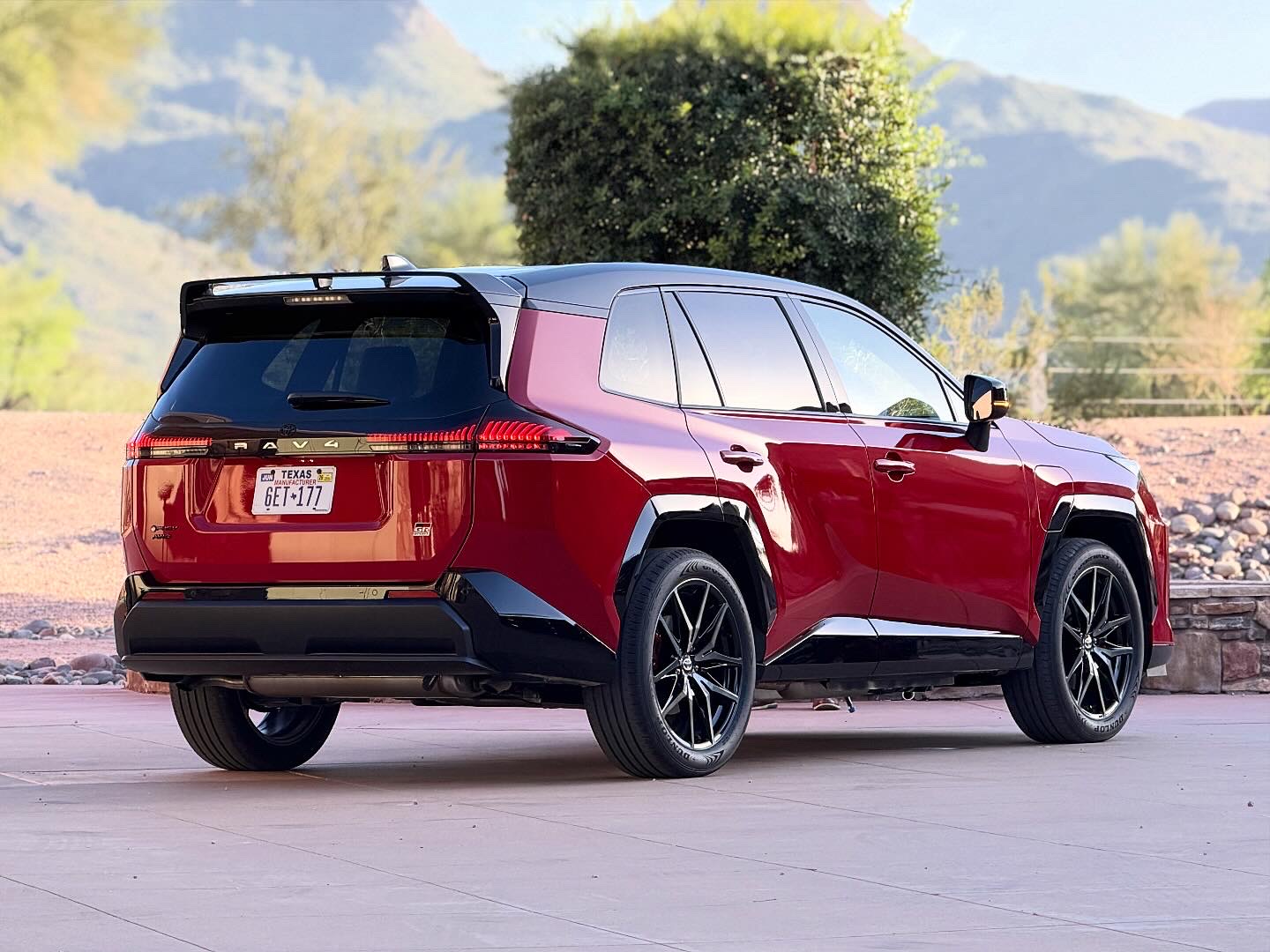
GR Sport:
For the first time, we’re seeing GR badging on a crossover in the Toyota Lineup. The new RAV4 GR-Sport has been developed in partnership with Toyota GAZOO Racing Company with some special looks and tuning. Up front is a larger GR functional matrix grille with upper and lower bumper aerodynamic ducts and front lip spoiler. There are slim vertical LED lights on the lower portion of the bumper to complement the standard hammerhead lights up top. GR badging is in the top corner of the grille and a blacked-out Toyota emblem sits atop the front of the fascia. Exclusive 20” offset black wheels are lighter and wrapped in summer performance tires with red brake calipers that have the GR logo. Beware if you live in the Midwest as you may want to pick up a second set of winter wheels and tires if you opt for this one. Around back is split wing rear spoiler, LED taillights, and a black bumper. Overall ride height is about 15mm lower giving it a more aggressive, planted look.
It also gets some special tuning with dedicated damper tuning and coil springs, rear suspension cross member reinforcement and lower arm cover, and front performance damper. There is a noticeable difference between driving GR Sport compared to the other models. Not only is it exclusively offered in the more powerful plug-in hybrid powertrain, but it handles much crisper. As 324 horsepower, it’s a quick SUV that can get going from 0-60 MPH in just over 5 seconds. Having the chance to push it on some twisty highway roads, it handled very well tracking corners nicely. Body lean was minimal as it confidently remained connected to the road. Give it a push in sport mode for the most engaging and dynamic feeling. It’s responsive, well-adjusted, and even absorbs the roadway well. While clearly not as nimble as a GR Corolla, it does add some spice and fun to the RAV4 lineup.
Woodland:
Gone from the RAV4 lineup is the TRD Off-Road and replacing it is the Woodland name and icon. Toyota insiders suggest this may be the model moving forward for non-body-on-frame vehicles at Toyota. The Woodland taps into the overlanding, outdoor space with a unique appearance, standard AWD, and the choice of either hybrid or plug-in hybrid powertrains. Woodland models have a 3,500 lb towing capacity that will allow you to tow a small camper, boat or adventure vehicle. It rides slightly higher than other grades with 8.5” of ground clearance, 20-degree approach angles, and 24-degree departure angles. While there is a trail and snow mode for driving, there is no low range for serious off-roading. I was impressed at how it handled articulation obstacles, scaled some small rock trails, and utilized downhill-assist control on a steeper decline. The downhill assist worked smoothly, however, did move a little quicker than I expected.
The exterior includes the aforementioned unique front fascia, all-terrain tires, and some exclusive color options like Urban Rock and Everest. It also comes with raised black roof rails with crossbars, a rear tow hitch receiver with wiring harness, and integrated RIGID Industries fog lights. It has piano black power and heated rearview mirrors with puddle lamps, camera, turn signal, and BSM indicators. Inside you’ll find SofTex-trimmed seats with 8-way power driver and 6-way manual passenger adjustments. Woodland branding along with red-orange accents throughout give it a rugged vibe. There’s an exclusive black and mineral interior color option (borrowed from the 4Runner Trailhunter) and uniquely patterned perforated doors and dash panels. Woodland all-weather mats keep the floors clean and easily washable.
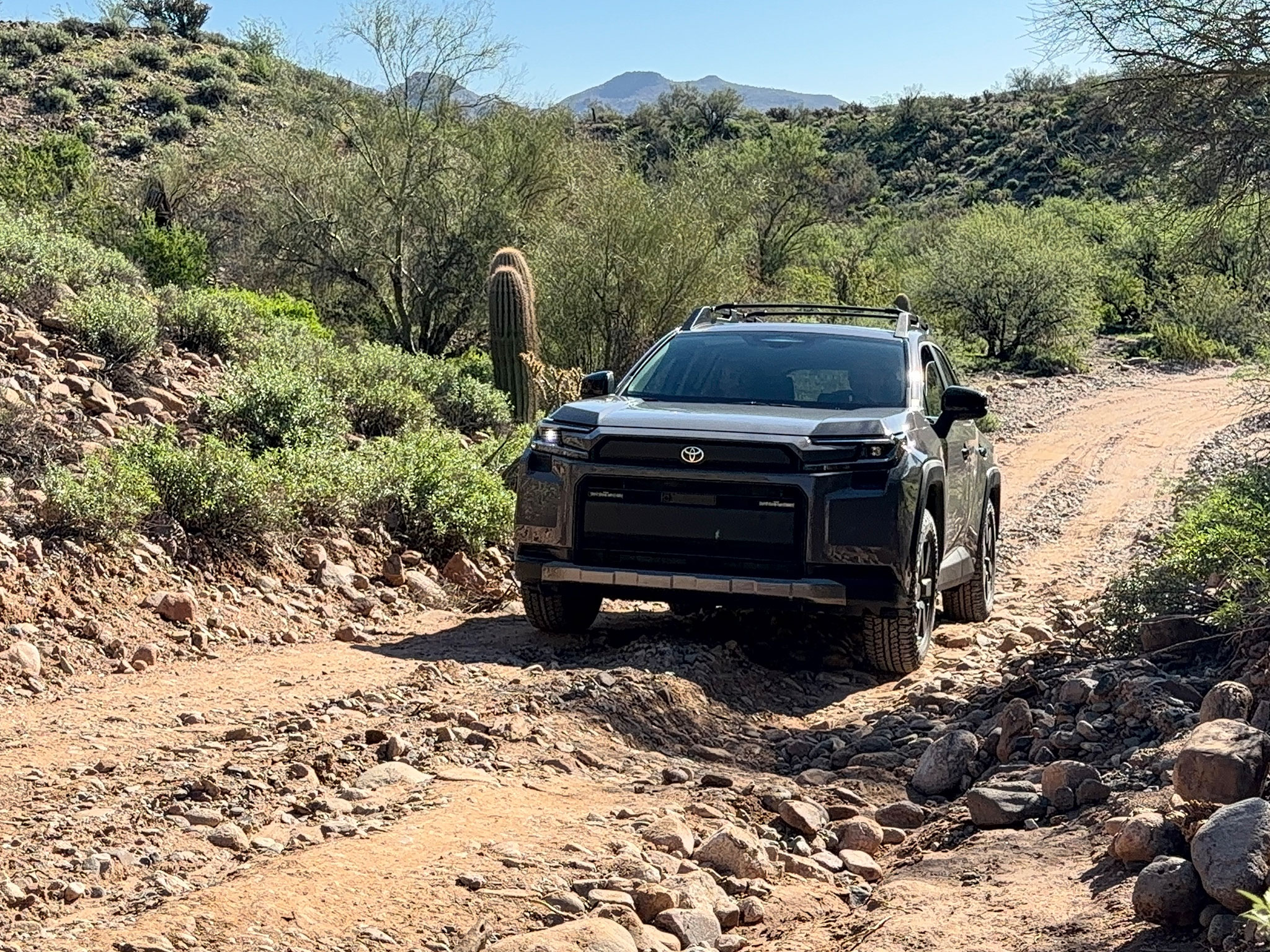
Powertrain (Hybrid):
As mentioned, all RAV4 models are now electrified meaning it is exclusively sold as a hybrid or plug-in hybrid. Gone from the lineup is the base gasoline-only engine. I had the chance to drive both and experience the differences. Hybrid models are equipped with a 2.5L 4-cylinder DOHC paired with an electric motor to deliver 226 horsepower (FWD) or 236 horsepower (AWD) combined and 163 lb.-ft. of torque. Both models are more powerful than the outgoing RAV4. The hybrid will get from 0-60 MPH in approximately 7 seconds with a little zip to it. The Hybrid delivers a noticeable improvement over the previous standard gas-engine RAV4 in terms of efficiency and responsiveness. The transition between electric motor assist and gasoline engine is seamless and smoother in stop-and-go driving than a traditional gas-only SUV.
There are several drive modes you can choose from that include Normal, Eco, Sport, Custom, Trail, and Snow. There are notable differences when choosing the different modes which can be done easily at the touch of a button in the center console. Power output is optimized in Sport mode and it's noticeable when you hit the gas on the highway to pass another vehicle. The suspension system is generally tuned for comfort, absorbing road imperfections effectively. While the hybrid may not offer sports-car-like agility, it provides a stable and composed ride suitable for daily driving. I took the hybrid through some suburban streets where many RAV4s will find homes, and in stop & go traffic, the hybrid continued to be smooth and subtle. Never did it have abrupt shifts or obvious start/stop moments at stop lights.
Powertrain (Plug-in Hybrid)
Also available for 2026 is the plug-in hybrid (PHEV) model which pairs the 2.5L 4-cylinder DOHC with two electric motors to deliver 324 combined horsepower and 172 lb.-ft. of torque (an increase from 2025’s top output of 302 horsepower). PHEV models are exclusively AWD and offer an electric-only driving range of around 50 miles depending on the grade. This is the powertrain I mentioned in the GR Sport above which has its own tuning. The PHEV powertrain is also available in the Woodland Grade as well as other Sport Grades that include the SE and XSE (2025 PHEV models were only available in two grades). For anyone who is hesitant about the plug, they shouldn’t be. It adds an electric range to the RAV4 that you can take advantage of, or you can forgo and enjoy the power that it comes with.
Outside the GR Sport, the PHEV still handles incredibly well with enough power to propel it from 0-60 MPH in around 5 seconds. At higher speeds on the highway, it provides the same effortless passing power with smooth shifting. This was a noticeable improvement over the hybrid model which felt a tad overworked in comparison. It’s smooth and well-grounded to the roads. There is a difference in ride quality when you compare grades, primarily due to the various tires. Woodland grades have more knobby all-terrain tires which do feel a little rougher on the pavement than an XSE PHEV. Regardless of the grade though, this is the most powerful RAV4 ever and continues to impress. The ride quality is comfortable and quiet as it rolled over road imperfections. It always felt grounded with minimal bounce or body lean when pushed, making it a very easy vehicle to drive. It includes an electronic on-demand all-wheel drive in which a separate rear-mounted electric motor powers the rear wheels when needed. The system provides enhanced stability and includes a driver-selectable trail mode to aid on uneven terrains. There is no low range for extreme off-roading as this one's ideal terrain is smooth pavement. While the Mazda CX-5 has always been the pinnacle of performance in this class, the RAV4 PHEV is certainly now among the most fun to drive compact SUVs I've had the chance to drive.
Range / Fuel Economy
All RAV4s come with a 14.5-gallon fuel tank and run on regular grade fuel. On a full tank, one can expect the hybrid to offer a driving range of around 600 miles. EPA estimates vary slightly between models and are outlined as follows for the hybrid:
City / Highway / Combines MPG
- 48 / 42 / 44 (FWD)
- 45 / 39 / 42 (XLE Premium, XSE AWD)
- 44 / 39 / 42 (Limited AWD)
- 41 / 36 / 39 (Woodland AWD)
These estimates are improvements over the previous model year. Opt for the Plug-in Hybrid for an additional electric driving range of around 50 miles (give or take a few depending on the grade) which is up from 42 miles on the 2025 model. PHEV models have an estimated driving range of 602 miles (including electric miles). Manufacturers estimated MPGe figures are 107 (SE, XSE), 101 (Woodland), and 98 (GR Sport). PHEV EPA estimates are as follows:
City / Highway / Combines MPG
- 44 / 38 / 41 (SE, XSE)
- 42 / 35 / 38 (Woodland)
- 41 / 33 / 37 (GR Sport)
Standard on the SE and GR Sport is a 7kW Onboard charger while the XSE and Woodland come with an 11 kW Onboard charger and DC Fast Charging capability.
Interior:
With a fresh exterior, it’s only fitting that the interior of the RAV4 also got an overhaul for 2026. Once again, each grade has its own flare, but all models now have more to offer. A larger 10.5” touchscreen is now standard on the LE, XLE, SE, and Woodland (up from 8”) and a 12.9” touchscreen is no standard on the rest of the lineup. Drivers will face a 12.3” digital gauge with crisper graphics and different displays for each drive mode. Overall materials are class appropriate and of higher quality. A mix of finishes and design elements give the interior a modern, but rugged vibe. Toyota has kept key physical buttons for quick access and efficiency for drivers. While the large touchscreen is still a focal point, the rest of the layout is thoughtful and purposeful. Below the touchscreen is a volume dial and climate controls. Below is an available wireless charging tray that keeps your mobile device in place on the left and has room on the right for a second device (in Limited models there is actually a second mobile device charger). To the right and above the glovebox, the RAV4 now borrows a cue from the Highlander and adds a shelf for front passengers.
The center console again varies based on trim as some models have a traditional gear selector while other higher grades have a toggle switch shift-by-wire shifter. I personally continue to be a fan of the more traditional selector as I’ve often struggled to get the toggle shifter tapped into neutral for the simple task of taking a vehicle through the car wash. Rounding out the center console are two cup holders and a large storage bin that not only opens on either side but also has a removable and reversible lid that can double as another holding tray. Toyota has also given the RAV4 sufficient USB-C ports to charge several devices. Also available is a heated steering wheel, digital rear view mirror, windshield deicer, and automatic rain-sensing windshield wipers. Up above the RAV4 is available with a power tilt/slide panoramic glass roof on the Limited grade or a standard power sunroof on the XSE.
Technology:
The 2026 RAV4 is the first Toyota to get the next-generation Toyota Audio Multimedia system. It wirelessly integrates with Apple CarPlay and Android Auto with ease at the touch of a few buttons. The new interface allows for more customization by owners including the ability to drag and drop widgets to customize the screen for the look you want. You can easily toggle between audio, phone, weather, drive modes, and navigation. If you do opt to use Apple CarPlay or Android Auto, those systems will continue to take over the entire screen, but you can quickly toggle back to the Toyota screens at the touch of a button.
Also updated is the virtual voice assistant that works in conjunction with the newly added AT&T 5G connectivity. The vehicle will respond to “Hey Toyota” commands or questions. You can use the voice commands to ask about the weather, navigate, skip songs, adjust climate, get vehicle stats and much more.
Within the new system there is also an updated section for plug-in hybrid models. A lightning bolt is the quick access icon to bring you to a menu for the EV domain in the system. It includes features synch as charge scheduling, charge limits, enabling/disabling external power supply, and more. EV routing is also incorporated to help you find the nearest charger.
Other features in the new system include an updated navigation system, access to Spotify, Sirius XM and a built-in Dash Cam. The Drive Recorder dash cam feature records and saves video clips using the vehicles’ external cameras. Drivers can record clips manually, from triggered events or on a continuous loop. Much like the 360-degree camera view, these videos are clear and crisp.
Seating:
The RAV4 offers seating for five with a mix of materials offered. There is an impressive amount of head, shoulder, and leg room up front. I found the front seats in all grades to be comfortable and supportive for longer drives. Front seats offer good support and the power adjustability in higher grades allow for optimal seating position and visibility. Rear seat leg room can get a little tighter if you’re riding behind a taller adult but is still competitive in the class. Rear head and shoulder room are good. Riding in the back I found the seats to be sufficiently comfortable and overall visibility was good.
Standard on the LE are fabric trimmed seats with manual 6-way driver and 6-way passenger seat adjustments. One step up to the XLE and the durable SofTex seats are standard along with 8-way power adjustable driver seats. XSE will introduce an UltraSuede mix with SofTex and GR Sport will add Brin Naub Suede. Sport models also add in blue or red stitching accents on the seats while Woodland adds red-orange interior accents. Heated seats are standard on the XLE and up, Limited adds ventilated seats and heated rear outboard seats which is impressive for this class. The heated and ventilated seats on the RAV4 all work well and quickly with different levels of adjustment.
Cargo:
With 37.8 cubic feet of space behind the second row and a maximum of 70.4 cubic feet when the rear seats are folded, the RAV4 offers more cargo capacity than many of its compact SUV rivals. Both figures have grown slightly over the previous model. RAV4 offers a power hands-free liftgate for easy access to load and unload.
Safety / Driver Assist:
The RAV4 comes standard with Toyota Safety Sense 4.0 that includes the following:
* Pre-Collision System with Pedestrian Detection
* Full-Speed Range Dynamic Radar Cruise Control
* Lane Departure Alert with Steering Assist.
* Lane Tracing Assist
* Road Sign Assist
* Automatic High Beams
* Proactive Driving Assist
* Front Cross Traffic Alert
* Driver Monitor
Additionally, standard convenience features include Blind Spot Monitoring, Rear Cross Traffic Alert, Safe Exit Assist and Back up Camera with Dynamic Guidelines. Toyota's Advanced Technology Package is also available on Limited, XSE, and Woodland grade and includes features like 3D Panoramic View Monitor, Advanced Park, Lane Tracing Assist, Traffic Jam Assist, and Front-Cross Traffic Alert. New in the RAV4 is the use of cameras when off-roading or using your turn signals. In both situations, cameras showcase the blindspot on the large multimedia screen in the center of the dash. When driving on trails in the Woodland in particular, the trail camera was very beneficial to see all around the RAV4.
Final Statement:
There is a lot to unpack in the new 2026 Toyota RAV4, but it’s all worthwhile and great additions to this best-selling vehicle. The keyword in the new model is versatility as it has added new grades, new themes, a variety of interiors, wheel designs, colors, and two different powertrains. The best part of the new RAV4 is that it is still very much a RAV4. Toyota did a great job advancing technology and design in this vehicle without losing sight of who this vehicle is for. Current RAV4 owners and buyers should be satisfied with the new model, and prospective buyers ought to be drawn in with new grades like the Woodland and GR Sport. Look for the hybrid RAV4 models to arrive by the end of 2025 and plug-in hybrids to start arriving in dealerships in spring of 2026.
*Toyota hosted me by providing travel and accommodations to drive the full range of the 2026 Toyota RAV4 for review.
